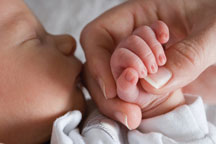
ASTM Crib Safety Standards Approved for Inclusion in U.S. CPSC Ruling
Revised Versions of F406 and F1169 Will Satisfy Requirements of Consumer Product Safey Improvement Act
In July, the U.S. Consumer Product Safety Commission proposed by unanimous vote that two ASTM International standards covering full-size and non-full-size cribs be incorporated as part of the regulatory requirements of Section 104 of the Consumer Product Safety Improvement Act. This vote successfully culminates an effort by numerous ASTM stakeholders to apply the dynamic nature of the voluntary standards development process to address regulatory needs and improve the safety of sleeping environments for our most precious and vulnerable citizens.
While commenting on the agency's July 14 approval of a notice of proposed rulemaking that aims to strengthen the federal crib standards for the first time in nearly 30 years, CPSC Chairman Inez M. Tenenbaum thanked CPSC staff, ASTM International, consumer groups, the industry and juvenile product experts for their outstanding work and collaboration in coming up with new voluntary standards. These consensus standards, approved by ASTM on June 1, represent significant improvements to the predecessor crib standards. Chairman Tenenbaum stated that the new voluntary standards include numerous safety requirements recommended by CPSC as well as elements from Canadian legislation (SOR/86-962, Cribs and Cradles Regulations) and a European standard (EN 716, Furniture; Children's Cots and Folding Cots for Domestic Use; Safety Requirements).
"I look forward to ASTM's continued dedication and cooperation with us as we move forward to develop future durable nursery product standards," says Tenenbaum.
The standards, ASTM F1169, Consumer Safety Specification for Full-Size Baby Cribs, and ASTM F406, Consumer Safety Specification for Non-Full-Size Baby Cribs/Play Yards, are under the jurisdiction of Subcommittee F15.18 on Cribs, Toddler Beds, Play Yards, Bassinets, Cradles and Changing Tables. F15.18 is part of ASTM International Committee F15 on Consumer Products.
In late 2009, Tenenbaum contacted ASTM International to enlist industry's help with the CPSC initiative to have a new mandatory regulation covering full-size and non-full-size cribs in place by the end of 2010. This initiative required that Subcommittee F15.18 evaluate the existing outdated federal regulations covering these product categories as found in 16 CFR 15081 and 1509; work with CPSC staff to evaluate data, hazard patterns and recent recalls to identify gaps or potential safety hazards not covered in the existing federal standards or voluntary standards; and develop new testing protocols and conduct lab tests to validate approaches. To meet the CPSC imposed timeline, it was required that the new language revising ASTM F1169 and ASTM F406 incorporate the relevant portions of the existing federal regulations and the newly developed protocols be developed, balloted and approved through the ASTM process by June 1.
Building on the recently published 2009 version of F1169 that was revised to eliminate traditional drop-side cribs and strengthen slat integrity, which are elements included in this proposed mandatory regulation, Subcommittee F15.18 developed new testing or strengthened existing testing protocols in the following areas:
- A revision to ASTM F1169 that incorporates the existing applicable requirements for full-size cribs from 16 CFR 1508, including general requirements, test methods and revisions to labeling;
- The addition of language to address entrapment in products attached to full-size cribs;
- The addition of general requirements that are currently included in other juvenile product standards but not in ASTM F1169;
- The addition of applicable requirements for mattress support systems;
- Changes to the crib side configuration; and
- Revision to the vertical mattress impact test.
Likewise, F15.18 undertook the task to approve revisions to ASTM F406 for non-full-size cribs. The revisions eliminate drop-side cribs, add requirements from 16 CFR 1509, add new warnings to address items added to the top of play yards, and include new requirements from the current version of ASTM F1169 that address movable sides.
Lastly, both standards were revised with the following improvements:
- Revision to the slat integrity requirements;
- The addition of language to ASTM F1169 and ASTM F406 to address misassembly issues; and
- The addition of language to address non-drop-side hardware/wood screws for ASTM F1169 and ASTM F406.
"The volunteer members of ASTM Subcommittee F15.18 (consisting of diverse stakeholders such as manufacturers, test labs, retailers, consumer representatives and regulatory authorities), with the strong support of and close collaboration with CPSC technical staff, representatives of the Juvenile Products Manufacturers Association, Health Canada and consumer organizations like Consumers Union, Kids in Danger and the Consumer Federation of America, dedicated an incredible amount of time and resources to accelerate the standards development process to meet this deadline," remarks Michael Dwyer, CAE, executive director, JPMA. "In particular, the manufacturing community has dedicated tremendous financial and technical resources to ensure the successful creation of this revised standard."
"The strengthening of the crib standard is a good example of how industry, consumer groups, government agencies and testing labs can work together in a consensus-building process to address serious safety hazards that imperil children," says Donald Mays, senior director, product safety/technical policy, Consumers Union.
Reference
1. Code of Federal Regulations, Title 16, Commercial Practices, 1508, Requirements for Full-Size Baby Cribs, and 1509, Requirements for Non-Full-Size Baby Cribs.
 SN Home
SN Home Archive
Archive Advertisers
Advertisers Masthead
Masthead RateCard
RateCard Subscribe
Subscribe Email Editor
Email Editor